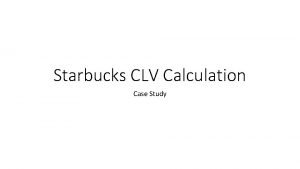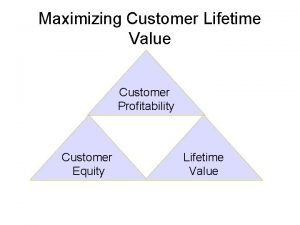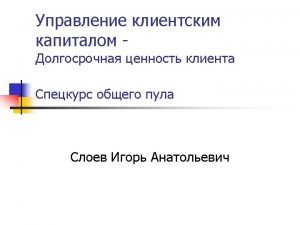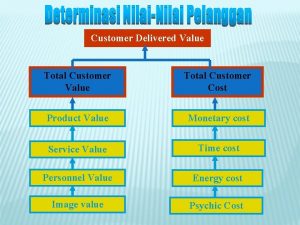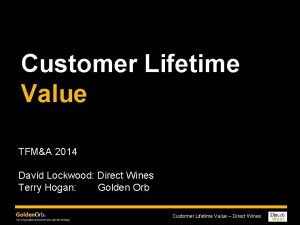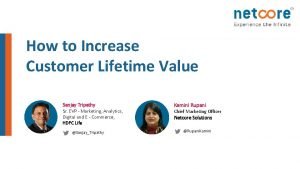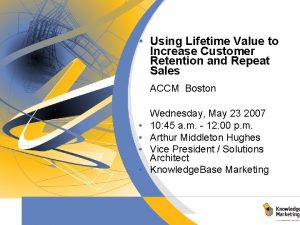A Customer Lifetime Value Framework for Customer Selection












- Slides: 12

A Customer Lifetime Value Framework for Customer Selection and Resource Allocation Strategy Rajkumar Venkatesan and V. Kumar (2004)

Objectives • Analyze the usefulness of Customer Lifetime Value (CLV) as a metric for customer selection and resource allocation strategy. • Developed and estimated an customer-level objective function, the goal of which is to measure CLV. • Compared the customer selection by CLV compared with other commonly used metrics. • Evaluated the benefits of designing marketing communications by maximizing CLV.

Framework for Measuring and Using CLV

CLV Objective Function • CLVi- lifetime value of customer i. • CMi, y = predicted contribution margin from customer i in purchase occasion y. • Frequencyi= predicted purchase frequency for customer i. • Ci, m, l = unit marketing cost for customer i in channel m in year l. • xi, m, l = number of contacts to customer i in channel m in year l. • r = discount rate. • n= forecast horizon • Ti = predicted number of purchases made by customer i until the end of the planning period

Purchase Frequency Model Antecedents of Frequency Upgrading Cross-buying Bidirectional communication Returns Frequency of Web Based Contacts Relationship Benefits Frequency of rich communication modes Frequency of standardized communication modes Intercontact Time Product Category Expected Effect + + + Inverted U

Contribution Margin Model Antecedents of CM Lagged Contribution Margin Total Marketing Efforts Total quantity purchased Size of the firm Industry Category Expected Effect + +

Data and Estimation • Data from large multinational software and hardware manufacturer. • Cohort 1: first purchase occurs in 1997 (1316 observations). • Cohort 2: first purchase occurs in 1998 (872 observations). • Data till 2000 used for estimation and data for 2001 used as a holdout sample. • Frequency model estimated using Markov chain Monte Carlo (MCMC) method. • Contribution margin model estimated using panel data regression • Endogeneity controlled for by using lagged variables.

Results Frequency Model CM Model

Customer Selection Strategy

Resource Allocation Strategy • Genetic algorithm used to optimize objective function. • Identified level of channel contacts which would maximize CLV depending on cost and responsiveness of customers. • Estimated increase in profits by $20 million among 216 customers. • Overall increase of $1 billion across entire customer pool.

Conclusions • Marketing communication across various channels affects CLV nonlinearly; • CLV performs better than other commonly used customer-based metrics for customer selection such as PCR, PCV, and CLD; • Managers can improve profits by designing marketing communications that maximize CLV.

Thank You
 Starbucks clv
Starbucks clv Lifetime customer profitability analysis
Lifetime customer profitability analysis Contoh value creation adalah
Contoh value creation adalah Balancing selection vs stabilizing selection
Balancing selection vs stabilizing selection Similarities
Similarities K selection r selection
K selection r selection Natural selection vs artificial selection
Natural selection vs artificial selection Difference between continuous and discontinuous variation
Difference between continuous and discontinuous variation 5 points of natural selection
5 points of natural selection Clumped dispersion
Clumped dispersion Natural selection vs artificial selection
Natural selection vs artificial selection Two way selection and multiway selection in c
Two way selection and multiway selection in c Multiway selection in c
Multiway selection in c
